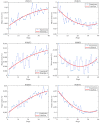A Preliminary In Vitro Study of 3D Full-Field Strain Distribution in Human Whole Premolars Using Digital Image Correlation
- PMID: 35329699
- PMCID: PMC8956105
- DOI: 10.3390/ma15062246
A Preliminary In Vitro Study of 3D Full-Field Strain Distribution in Human Whole Premolars Using Digital Image Correlation
Abstract
Full-field measurements can provide a more complete description of the behavior of human whole tooth under load. To that end, in vitro experiments were carried out to measure the full-field buccal surface strains of human premolars free of caries and abrasion using digital image correlation (DIC). Experimental results show that both the value field and the orientation field of strains can be observed exactly, both of which contain a wealth of information. Furthermore, the strain distributions between the crown and the root of specimens were significantly different (p < 0.001). An interesting observation was a watershed at the cementoenamel junction (CEJ) which separates the orientation field of strains into two distinct parts; the watershed was also observed in the value field of strains in some specimens whose geometries changed obviously at the CEJ. Another interesting observation was that the minor strains increased linearly from cervical to apical regions in the root cementum. Experimental results also support the viewpoint that mechanisms of non-carious cervical lesions (NCCLs) may in part be due to the changing orientation of tensile strains, as well as their magnitude, and they also support the hypothesis that occlusal force can contribute to root fractures.
Keywords: buccal surface strain; digital image correlation; full-field measurement; human premolars.
Conflict of interest statement
The authors declare no conflict of interest.
Figures










Similar articles
-
Strain patterns in cervical enamel of teeth subjected to occlusal loading.Dent Mater. 2000 Nov;16(6):412-9. doi: 10.1016/s0109-5641(00)00036-1. Dent Mater. 2000. PMID: 10967190
-
Stress-strain Analysis of Premolars With Non-carious Cervical Lesions: Influence of Restorative Material, Loading Direction and Mechanical Fatigue.Oper Dent. 2017 May/Jun;42(3):253-265. doi: 10.2341/14-195-L. Epub 2017 Mar 13. Oper Dent. 2017. PMID: 28467256
-
Tooth morphology and characteristics of non-carious cervical lesions.J Dent. 2006 Mar;34(3):185-94. doi: 10.1016/j.jdent.2005.05.005. Epub 2005 Aug 19. J Dent. 2006. PMID: 16112334
-
Full-field in vitro investigation of hard and soft tissue strain in the spine by means of Digital Image Correlation.Muscles Ligaments Tendons J. 2018 Apr 16;7(4):538-545. doi: 10.11138/mltj/2017.7.4.538. eCollection 2017 Oct-Dec. Muscles Ligaments Tendons J. 2018. PMID: 29721455 Free PMC article. Review.
-
Digital image correlation in dental materials and related research: A review.Dent Mater. 2021 May;37(5):758-771. doi: 10.1016/j.dental.2021.02.024. Epub 2021 Mar 11. Dent Mater. 2021. PMID: 33715864 Review.
References
-
- Shahar R., Weiner S. Insights into whole bone and tooth function using optical metrology. J. Mater. Sci. 2007;42:8919–8933. doi: 10.1007/s10853-007-1693-8. - DOI
-
- Picart P., Fages M., Slangen P., Xia H., Montresor S., Guo R., Li J., Solieman O.Y., Durand J.C. A review on optical methods to assess dental behavior under stress; Proceedings of the SPIE, Optical Methods for Inspection, Characterization, and Imaging of Biomaterials IV; Munich, Germany. 21 June 2019.
Grants and funding
LinkOut - more resources
Full Text Sources

